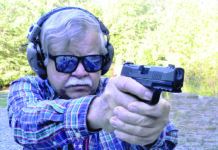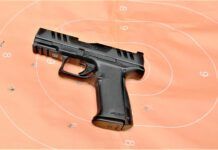We just learned that Charles Daly has discontinued its HP model ($550 MSRP), a close copy of the Browning Hi-Power. Used Browning Hi-Powers go for $750 or so. New, theyre $922 on up. The Daly HP commonly sells in the neighborhood of $350 on the street. So if you could get a decent version of the Hi-Power 9mm single action for that amount, it might well be all the Hi-Power you need. Weve had a Charles Daly HP (Daly never calls it a Hi-Power on the guns markings or in the manual) on hand, waiting for a suitable test matchup. Because of its recent discontinuation, we thought you might like to know what its all about while the Daly HP is still somewhat available, so we quickly came up with another high-capacity 9mm to test against it.
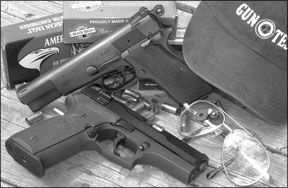
The second test gun used to be made by Beretta as a smaller and lighter version of the 92, yet still is pretty much a full size DA/SA auto. It is now being made in Turkey, using Berettas machinery, and is sold under the Stoeger name (a Beretta subsidiary) as the Cougar Model 8000. As a Turkish gun, its price has come down drastically from around $650 to an MSRP of $449. Street price as we found it is $390. We didnt much like running a DA against an SA, because we thought theyd never compete. We were surprised at the results.
We tested both guns with Fiocchi 115-grain JHP, with American Eagle 115-grain ball, with Black Hills 147-grain ball, and with 115-grain JHP by Ultramax. Loading the magazines for both guns was not easy. In fact we found it to be very painful on the fingers, from sharp edges and high forces needed against powerful springs, on both guns. We suspect many women will not like these two guns because of the extreme forces necessary to load their magazines by hand. A suitable loading aid would help immensely. Each magazine would fit the well of the other gun, but neither would latch properly.
Heres what else we found.
Charles Daly HP 9mm, MSRP $550, Street $350
The Daly HP was all matte blued but for the slide stop, safety and hammer. The slide sides were brush-finished before bluing. The bluing was well done. Tactically, this overall dull finish is superior to that of the highly-polished Belgian guns, even if it doesnt look as pretty. It doesnt glow in the dark. In fact most custom Hi-Powers are refinished with non-glossy surfaces. Externally we could not fault the guns workmanship or appearance in any way. Inside, some of the machining was on the rough side, but it all appeared to be sound workmanship. The first thing we did was deburr the magazine so we would not cut our fingers while loading and handling it. Browning magazines apparently work in the HP. Charles Daly HPs were assembled in the U.S. by both Dan Wesson and Magnum Research. Those with serial numbers beginning with “HPM” were done by Magnum Research.
The gun was all steel but for the grip panels, which were checkered hard rubber or polymer, with just the right amount of friction. The grip was big, thick, massive, and not for tiny hands. It was comfortable. We thought it was more pleasant in the hand than a 1911s grip. Then we noticed the web of our hand overlapping the web-guard portion of the frame in back, a clear invitation to get bitten by the hammer. We quickly discovered the Dalys hammer
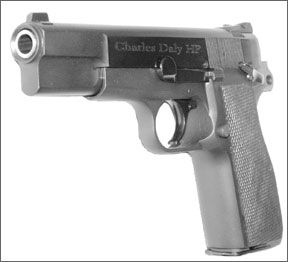
would not fall with the magazine removed. Here were two things Daly could have altered to vastly improve the Hi-Power, yet they didnt bother. Some sort of extension to the grip frame, not necessarily a beavertail (like what S&W did to the old PPK), would have helped sell these guns, and so would have doing away with the bothersome magazine disconnect. As it is, the magazine wont fall free from the gun, which slows reloads immensely.
In case the reader has been living in a cave the past 50 years or so, the Charles Daly HP is a very close copy of the Browning Hi-Power, one of John Brownings famous designs. It is a single-action auto, like another of Brownings designs, the Colt 1911. That means tactically you carry it cocked and locked. The Hi-Power-as made by anyone-has some advantages, which some think are offset by the big disadvantage of not being available in 45 ACP. Among its prime features is a magazine capacity of 13, or in the Daly HP, 14 rounds, plus another in the chamber. At the time of the Hi-Powers introduction, 1935, no other pistol had a magazine capacity that big. Along with high capacity came a wide body, and as noted, those with small hands dont much like that. But the average male hand does rather well with the big grip. It also makes for shooter comfort, though even the hottest 9mm rounds dont kick all that much.
The Charles Daly HP had the round “Commander-style” hammer. It also had a decently big and easily hit safety on the left side only, and a set of express-rifle sights that you either loved or hated. We loved them. The rear sight was a wide-angle V with prominent white center line. The front was a large white bead, which gave a perfect sight picture. In use, the bead sits in the bottom-center of the wide V, so you see the whole bead and nothing but the bead in the V. Then you put the target on top of that bead. That big white dot was readily visible in poor light. If youre in a big hurry, there are no sights that are faster than this setup, provided you have some familiarity with them. Some shooters are more used to Patridge sights and can shoot them faster. Suffice to say these worked well for us, gave excellent accuracy, and were extremely fast to get on target. We might not want them for formal target shooting, but they do work. Those of us who have similar sights on double rifles have made groups at 100 yards in the 1-inch range, with good rifles.
We noted the sights and the entire slide was smooth and slick, so clearance drills would not cut the hands. We did, however, have a stovepipe when we were purposely limp-wristing the gun, and it
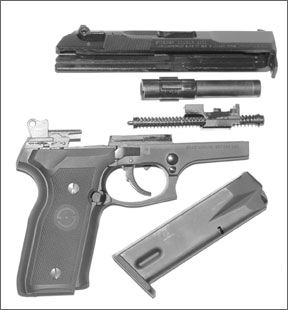
was by no means as easy to clear as with a 1911. The case is just too small and was stuck too deeply within the slide to wipe it clear. We dont consider that lone stovepipe to be a fault, but we had a failure to feed, during chronographing, that was a fault. The fired case stuck in the chamber, with the upcoming round jammed against its rear face. The recovered case showed a tear in its rim from the extractor. Although this never happened again, we did note several ejected cases had roughness from the extractor on their rims. Some tuning attention seems to be in order. Accuracy was acceptable, though everything landed about 2 inches high at 15 yards.
The stunning popularity of the 1911 (and its normal cartridge) has transformed it into a reasonable fighting machine. Its hard to buy any 1911 today that isnt pretty close to street ready. No longer is it necessary to have it retrofitted with all the desirable items like beavertails, good sights, decent safeties, etc., that make it a better pistol. But the Hi-Powers as made today are still basic 1930s design, with attendant hand-biting, lousy triggers, useless mag disconnects, etc. The Hi-Power hasnt evolved because not enough shooters are all that serious about using a SA 9mm. Charles Daly had a chance to change that, but chose to clone an old design. We suspect it hurt them, and so they dropped it.
Stoeger Cougar 8000 9mm, $449 MSRP, $390 Street
There is also a 40-cal version of the Cougar with 11-round capacity for the same price. The gun in either caliber comes with two magazines The Turkish-made Cougar was a blocky, bulky handgun that, frankly, we didnt think wed much like. Its bulky grip was at least as big as that of the Daly HP, which aided in giving the Cougar a 15+1-round capacity in 9mm configuration. The gun was lighter than the HP, a touch shorter, but blocky-looking on its front. That meant it wouldnt fit into a standard 1911-style holster, which the HP did. The light weight was thanks to an aluminum frame.
On its surface, the Cougar was a well-finished handgun. The steel slide had a smooth, almost greasy look. The matte-black frame had similar-finished checkered grip panels made of hard plastic. There were vertical serrations on the front and rear grip straps that gave good control to the hand-filling gun. There was an ambidextrous safety that dropped the hammer if it was cocked, and prevented firing the gun by disconnecting the trigger, when the safety was down. We could operate these twin levers with the strong-hand thumb, but it was not easy. The large trigger guard had a hook at its front for those who prefer to wrap a finger of the weak hand around the front of the guard. Yes, there are excellent shooters out there who still grip the gun like that, including a former IPSC World Champion.
The sights were great. Three white dots set off the Patridge-type, fixed units adjustable only by drifting for windage. The sight picture was excellent, and the rear sight was smooth enough on its front surface that it would not cut the hand during clearance drills. All the guns controls were well placed and functioned properly. The magazine fell free when the button was pressed, and you could fire the gun with the mag out. Another button on the right side of the gun, above the front of the trigger guard, permitted the
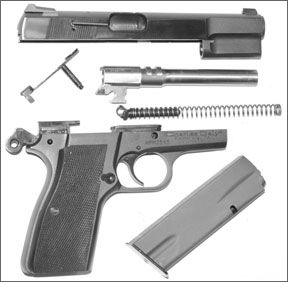
disassembly of the Cougar. Take the magazine out first, and when you clean any gun always make sure it is completely unloaded. Press that button in, and turn down the takedown lever on the left side. The slide may now be removed forward off the gun. Inside youll find a big surprise.
The barrel locks by rotation. You can see the barrel rotate as you pull the slide rearward. It spins within the slide much like a bolt on a bolt-action rifle, the barrel having lugs and the slide having recesses for them. This means the barrel stays concentric with its original location within the slide as the gun cycles. The makers claim this aids accuracy, but those of us who know better realize accuracy depends more on fitting than on the lack of motion of the barrel, or its location, during the reloading cycle. However, the system is mighty clever, makes for an easily-moved slide, and was masterfully made. All the stuff inside this gun was beautifully finished and machined. There was even an arrow on the one questionable part inside that might cause confusion during reassembly. Point the arrow towards the muzzle and it all falls easily back together. We were favorably impressed by the design here, and by its execution. The manual was helpful, even though many of its photos were hidden inside the front cover. From the manual we learned the magazine release button can be reversed for lefties. So, we thought it was a nice gun, on the surface of things. Now, if it would shoot….
At the range we found the Stoeger 8000 Cougar had accuracy generally a bit better than that of the Charles Daly HP. We liked the clean SA trigger, which broke at 6.0 pounds. There were no failures of any sort with the Cougar. It fed, fired, and ejected perfectly everything we threw at it. The trigger broke a bit too far toward the back, for our taste, but thats something you get used to. We would have liked a lighter pull, but as youll see, the heavy SA pull played well with the DA pull for fast shooting.
We tried the Cougar against the HP for two quick shots, from 7 yards away. The common problem with a SA/DA pistol is that they are what Jeff Cooper called “crunchentickers.” You need a crunch on the trigger for the first shot, and then barely a “tick” for the second shot of a fast pair. The DA pull here was a smooth, long pull that measured 9.8 pounds but felt a lot lighter. The SA pull was 6 pounds, so there was not a great difference between the two. We tried fast pairs DA/SA to prove to ourselves it was no fluke, but most of our shots went into the 4-inch black of the target. We could not do as well with the Daly HP on fast pairs, with our limited testing. The advantage for the HP was that for our SA-trained shooters, the first shot with the Daly HP was noticeably faster than the first shot with the Stoeger Cougar. As we moved back we found the first, DA, shot with the Cougar was very much slower than the first, SA, shot from the HP. Gunfighters will always prefer the same trigger for every shot, and here the HP shined. However, the Cougar is the first DA/SA handgun many of us have actually liked. It worked well, and if this is your only handgun, it ought to work just fine for you.
0708-MIDSIZE-PISTOLS-ACCURACY.pdf
0708-MIDSIZE-PISTOLS-REPORT-CARD.pdf
















